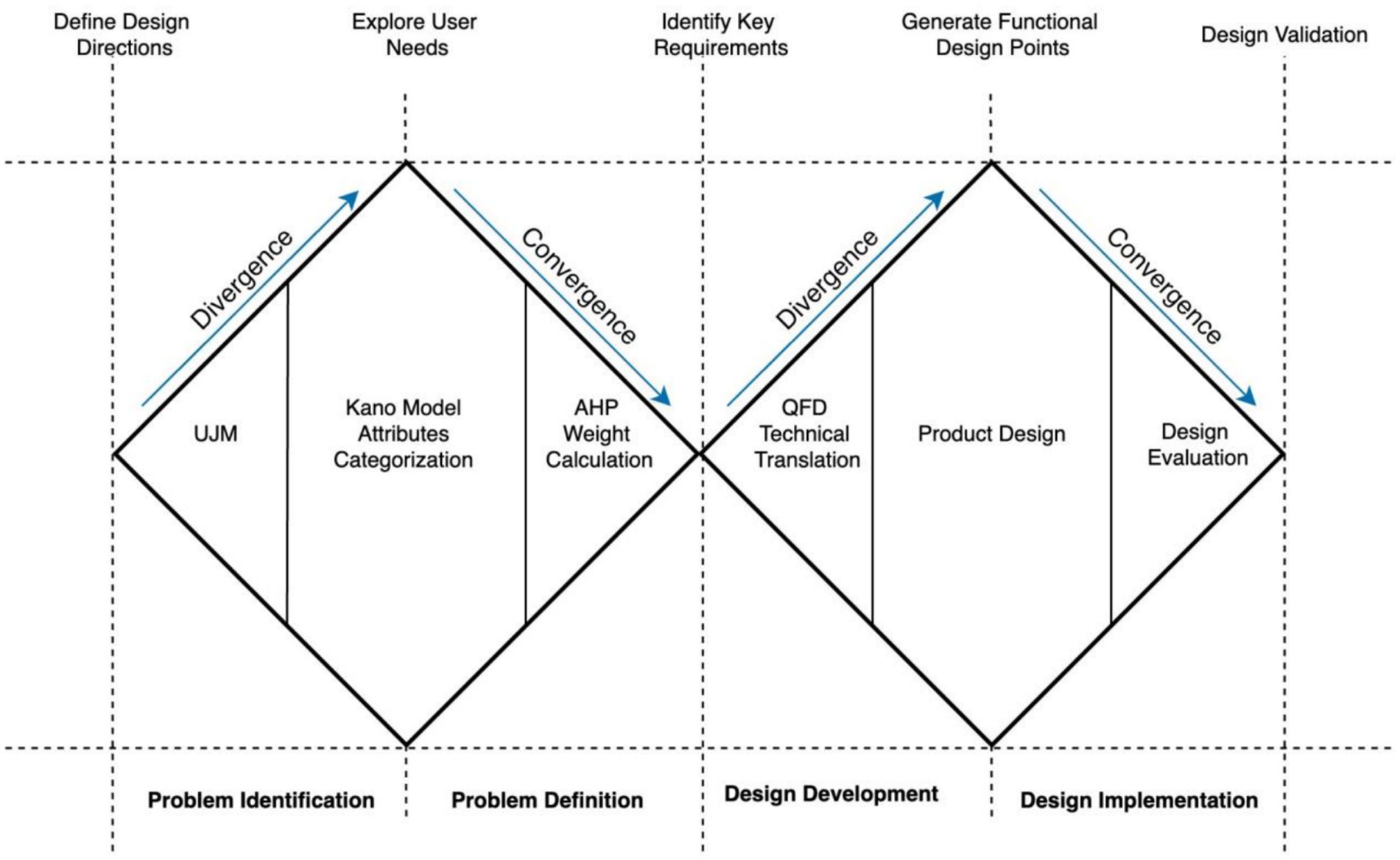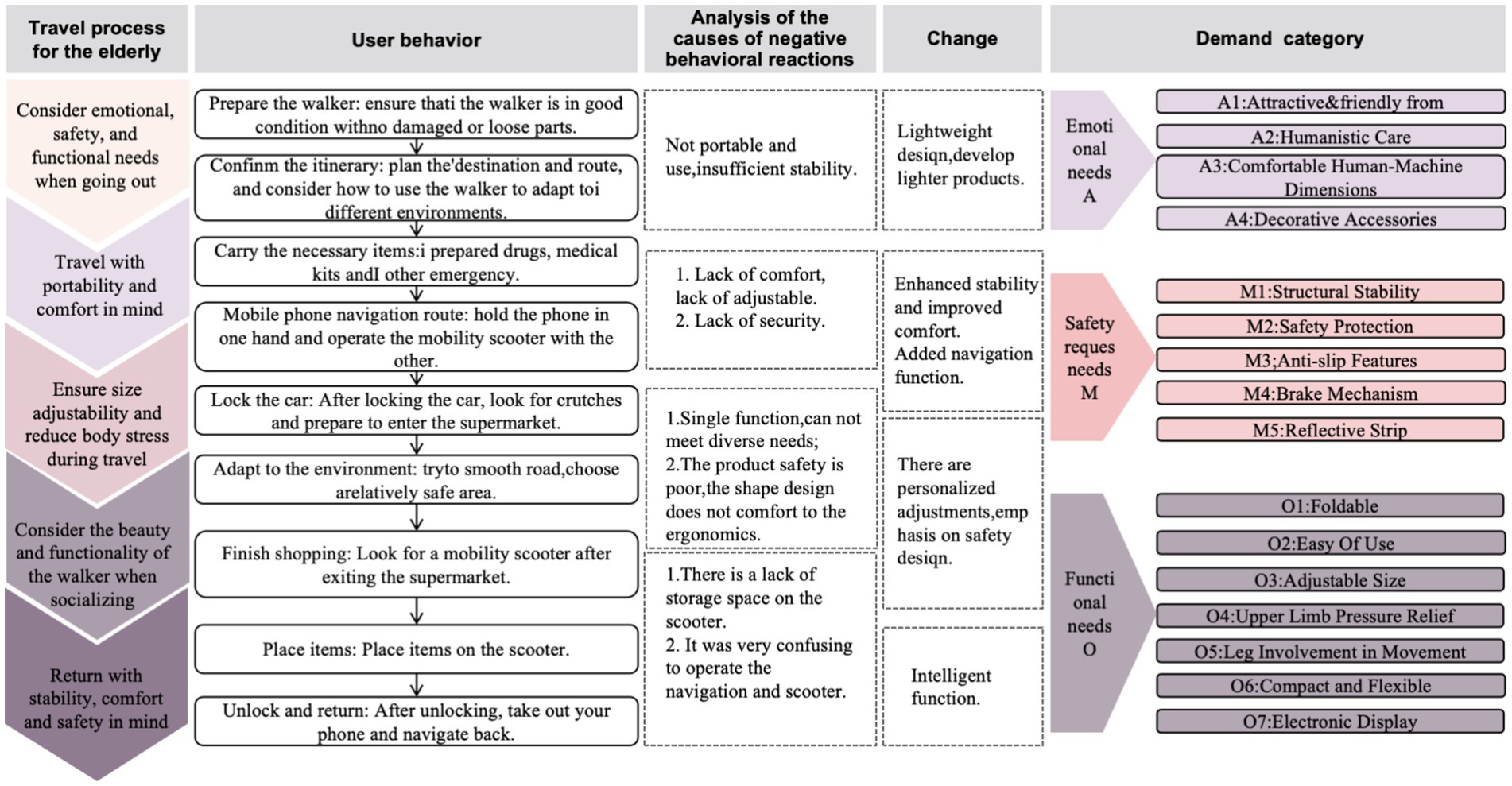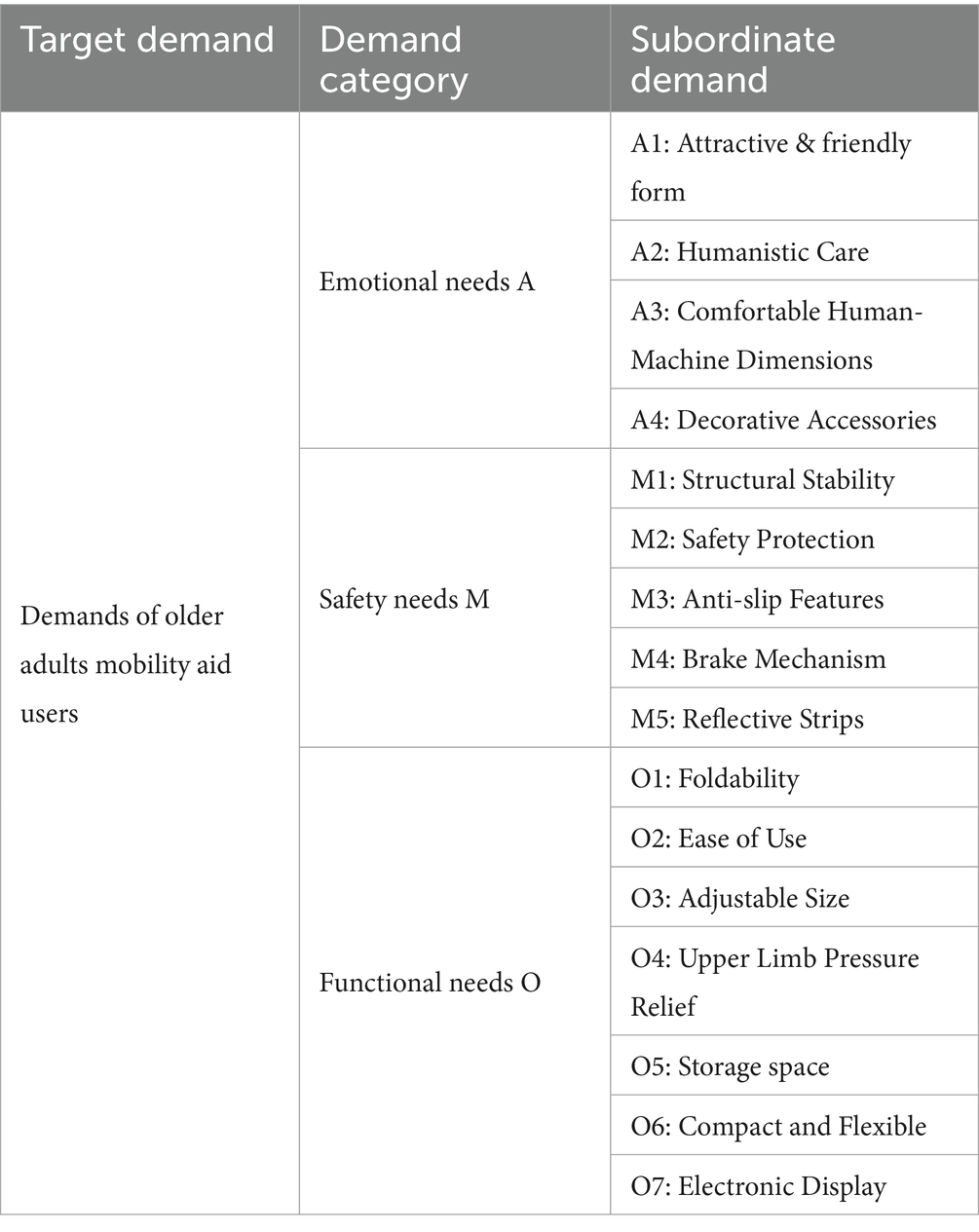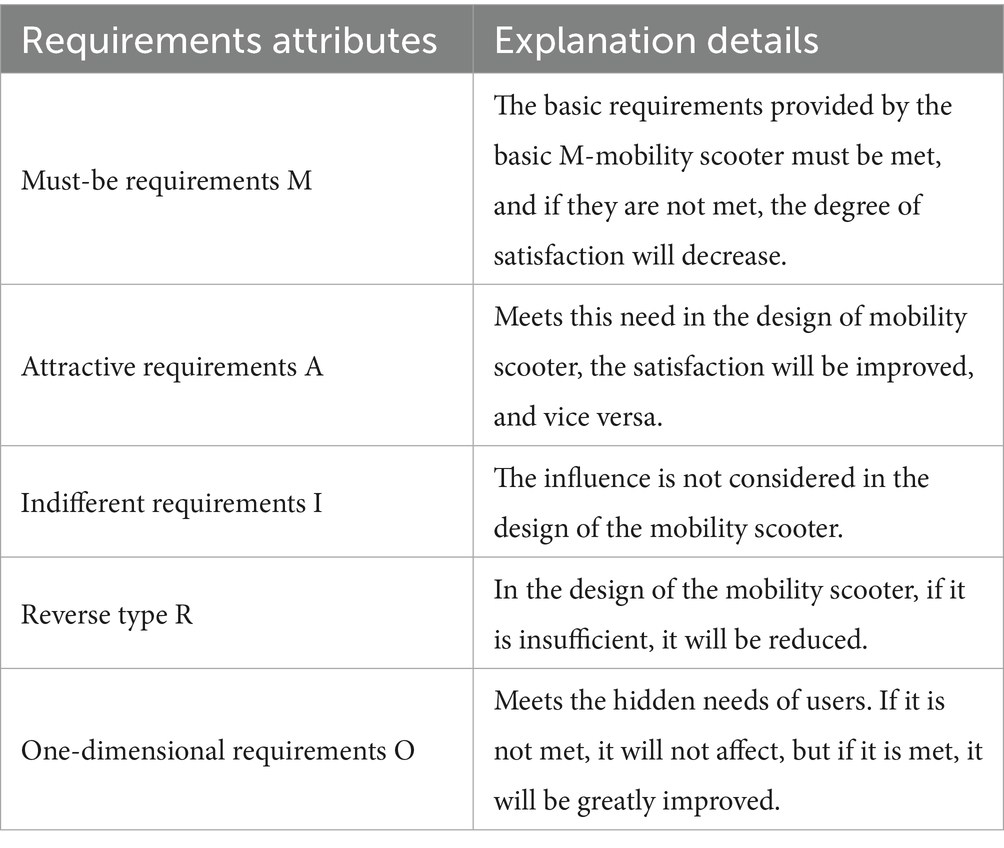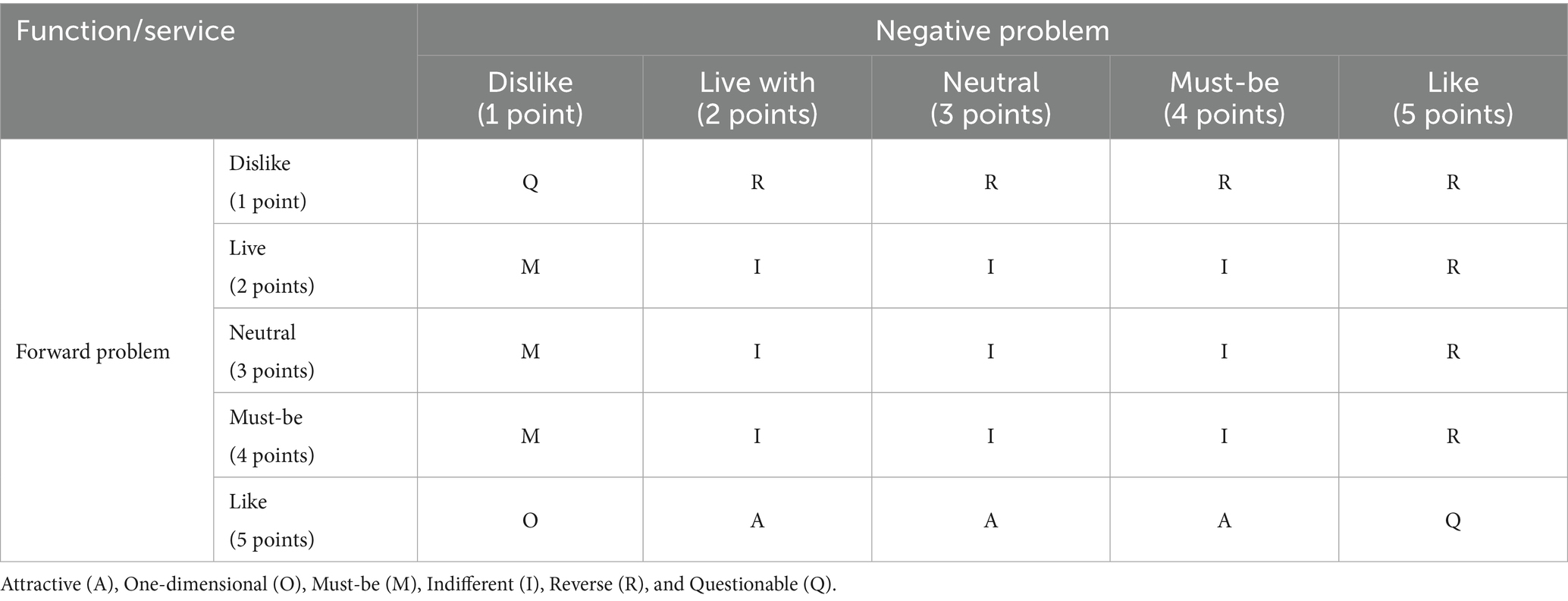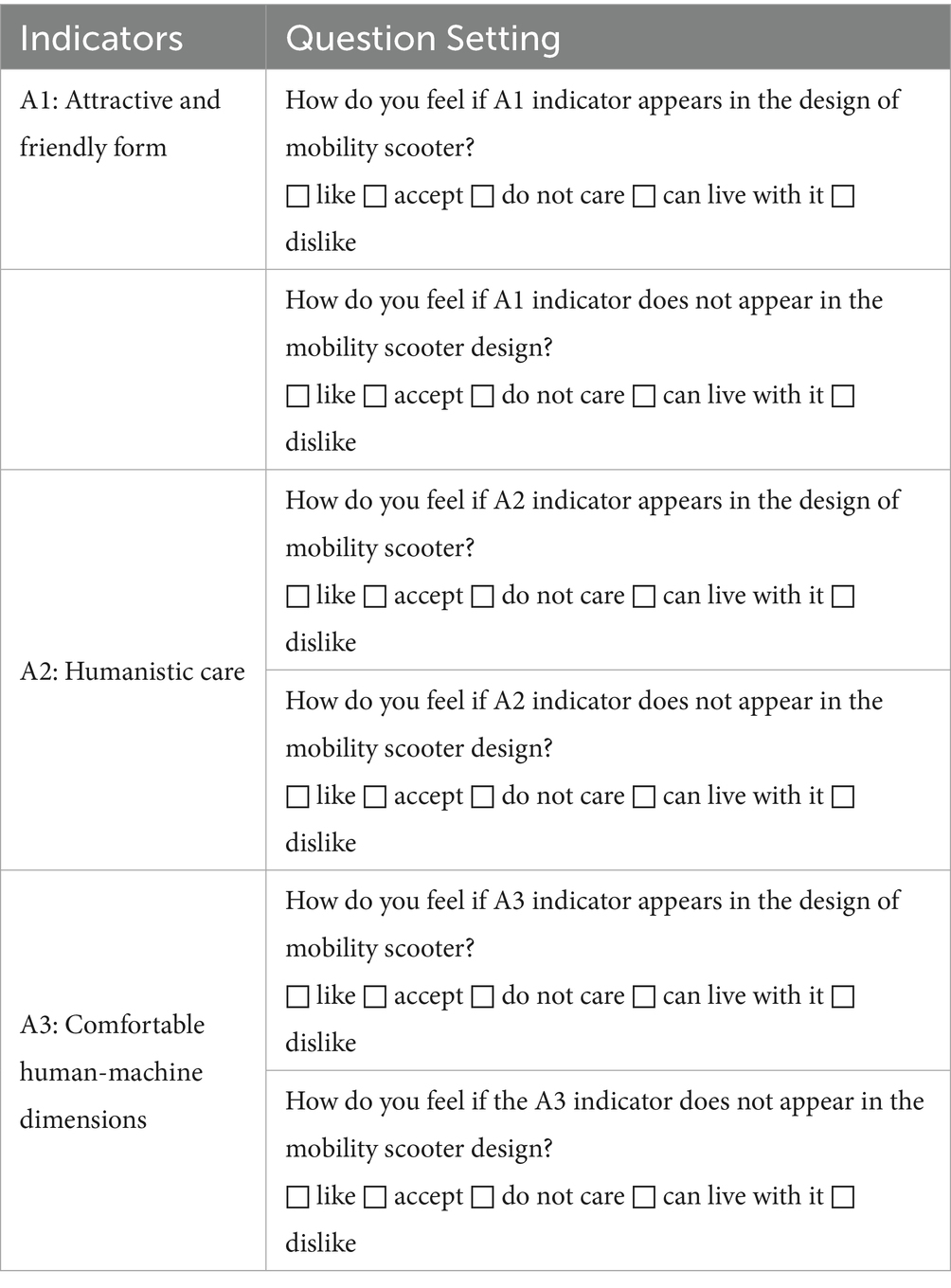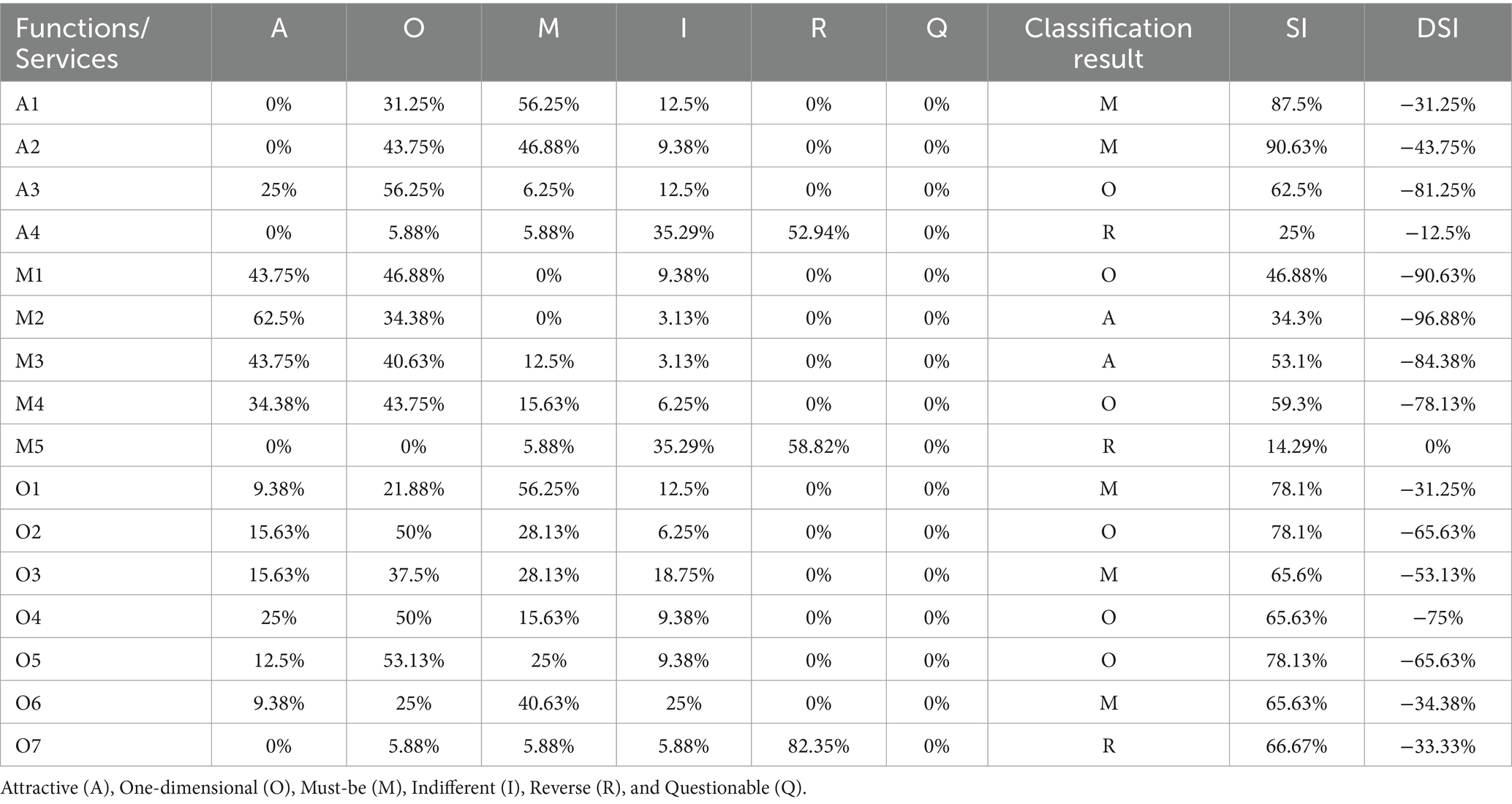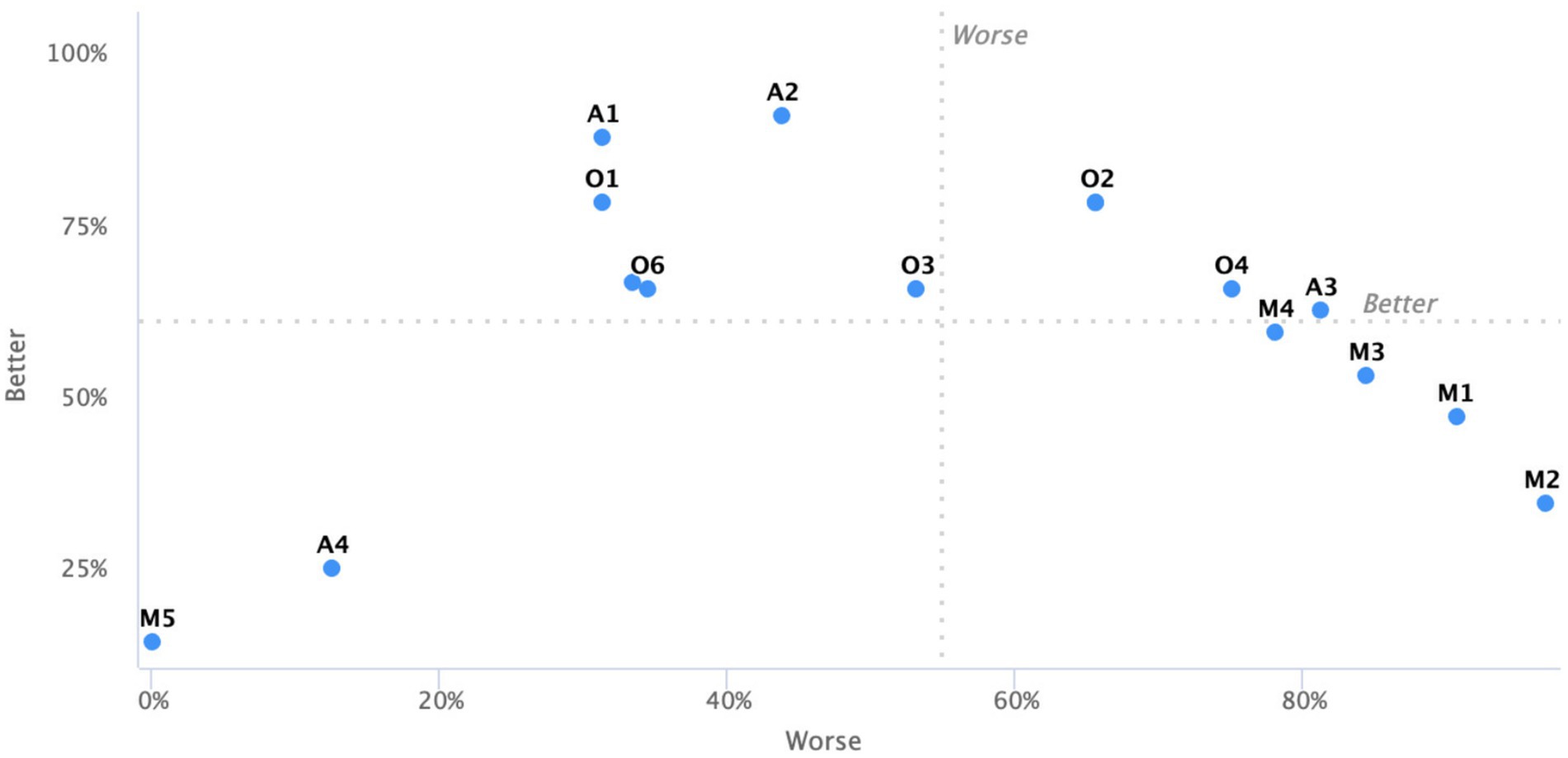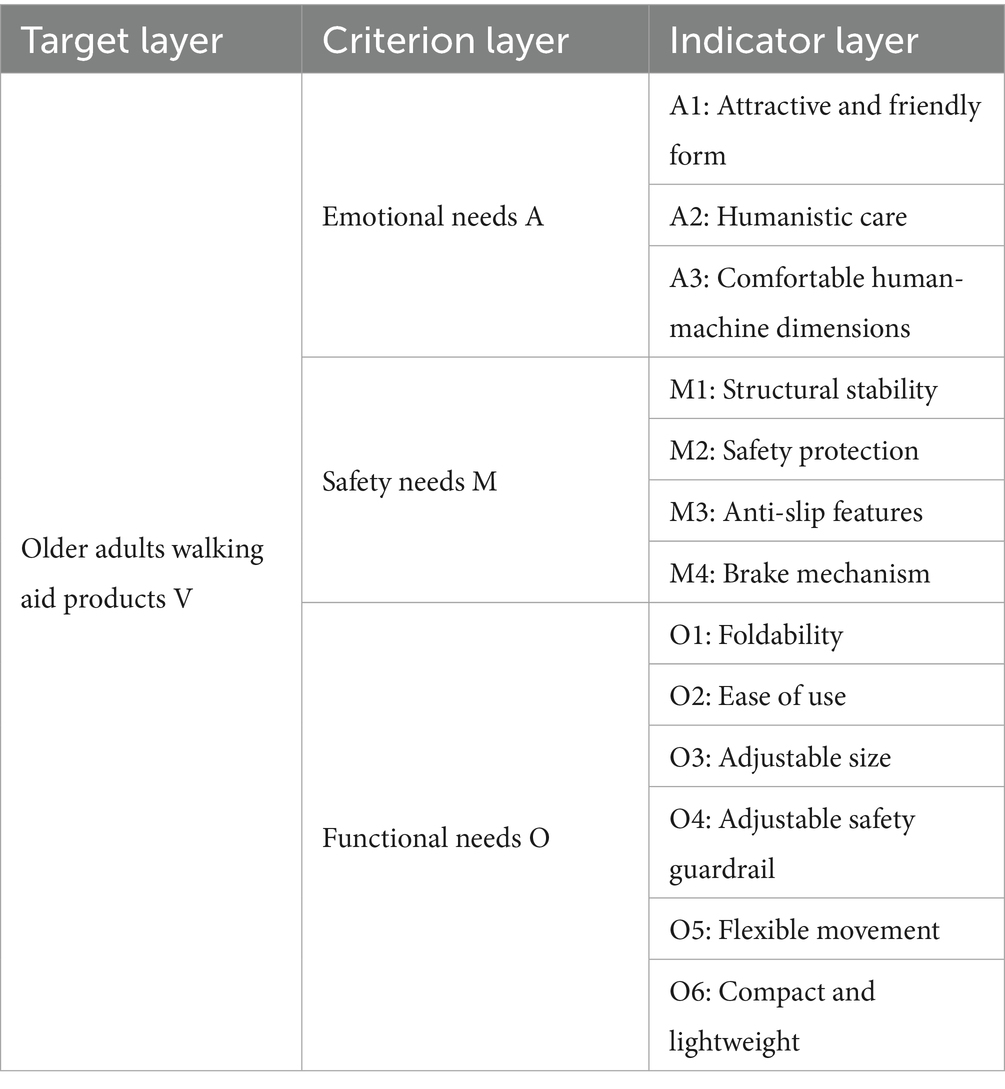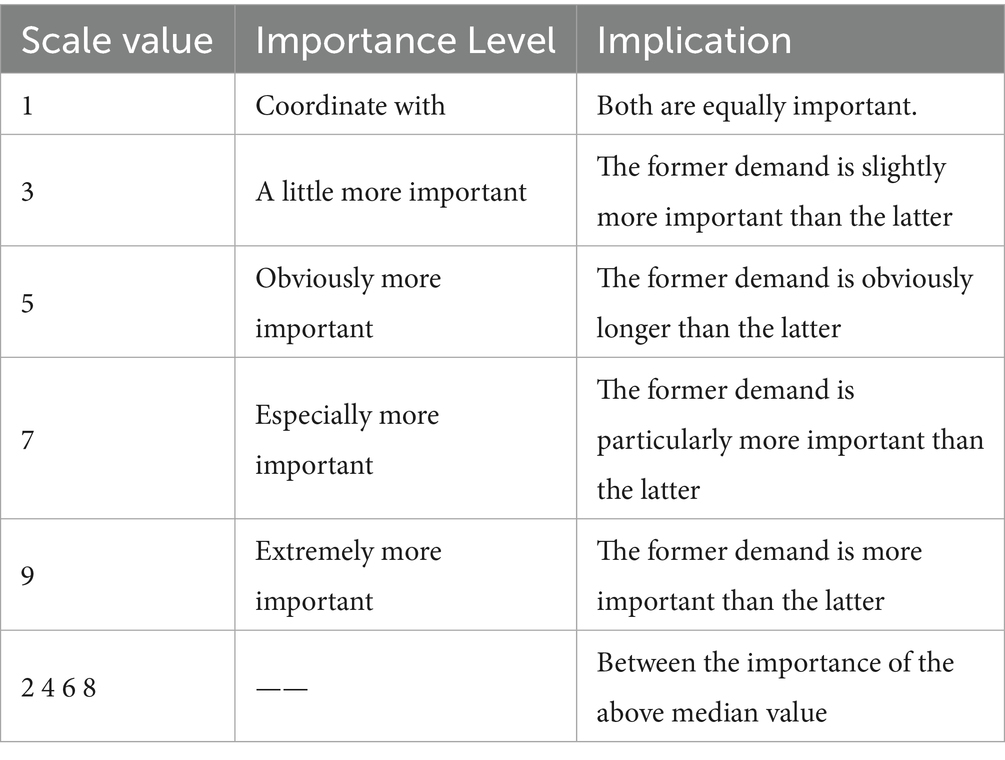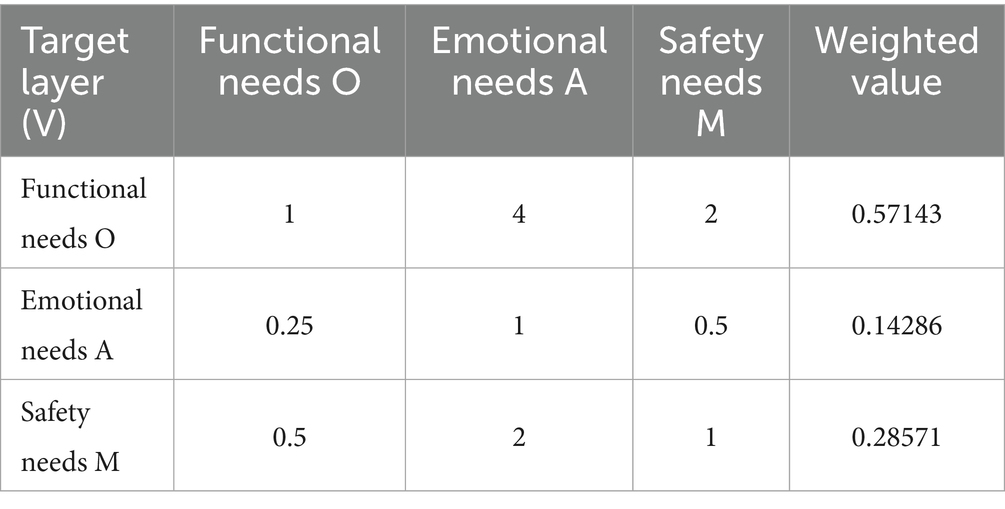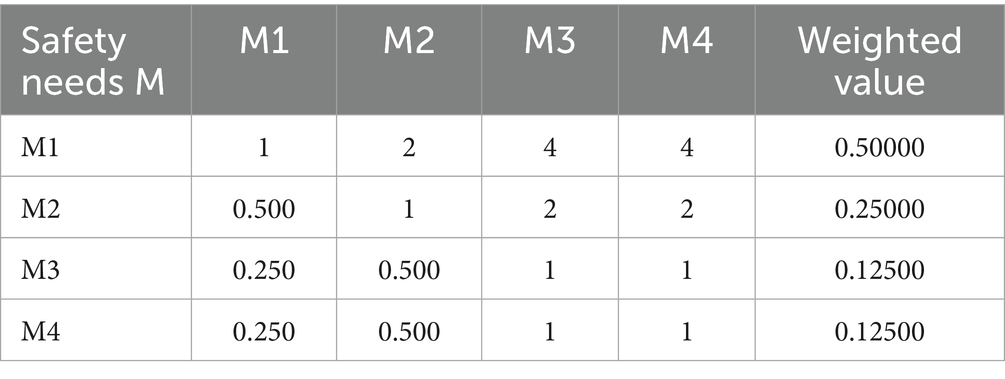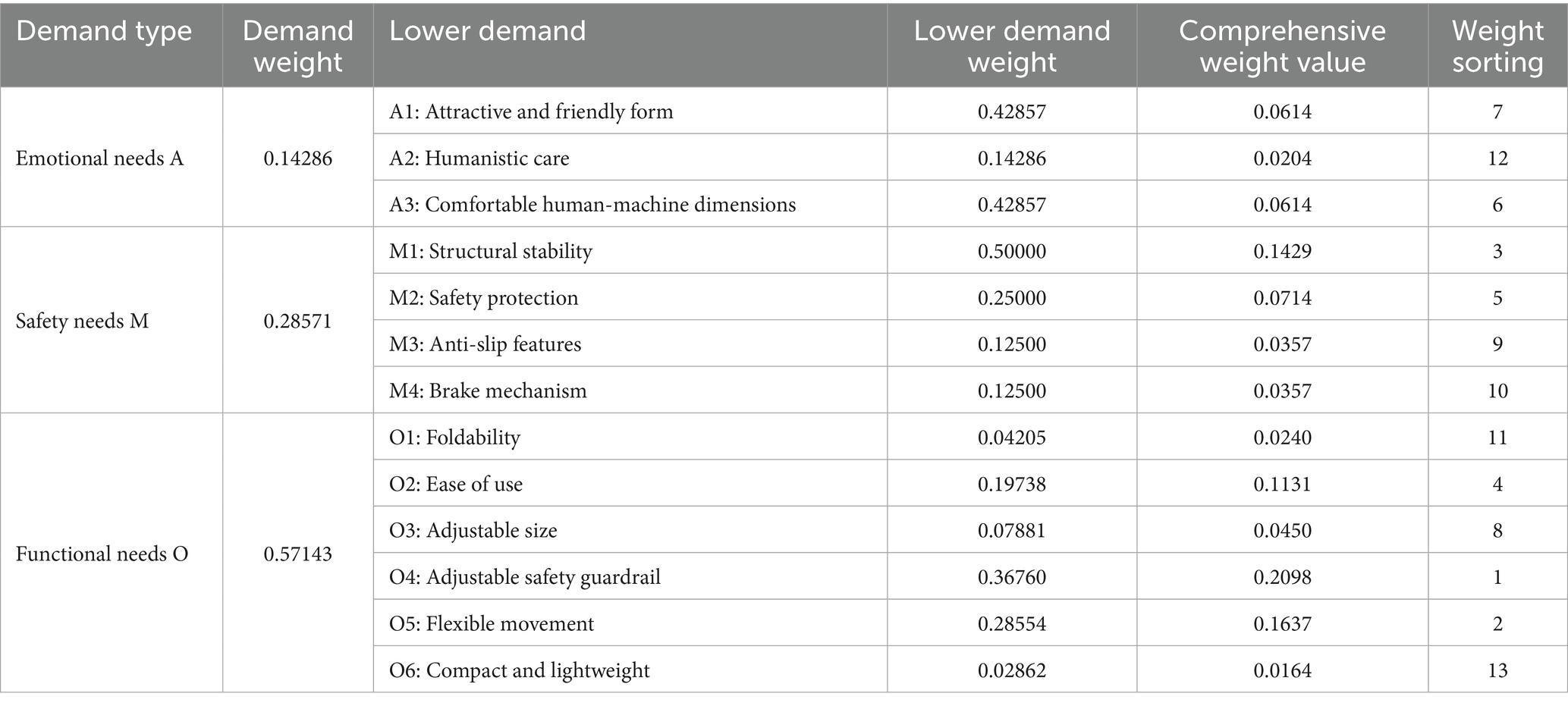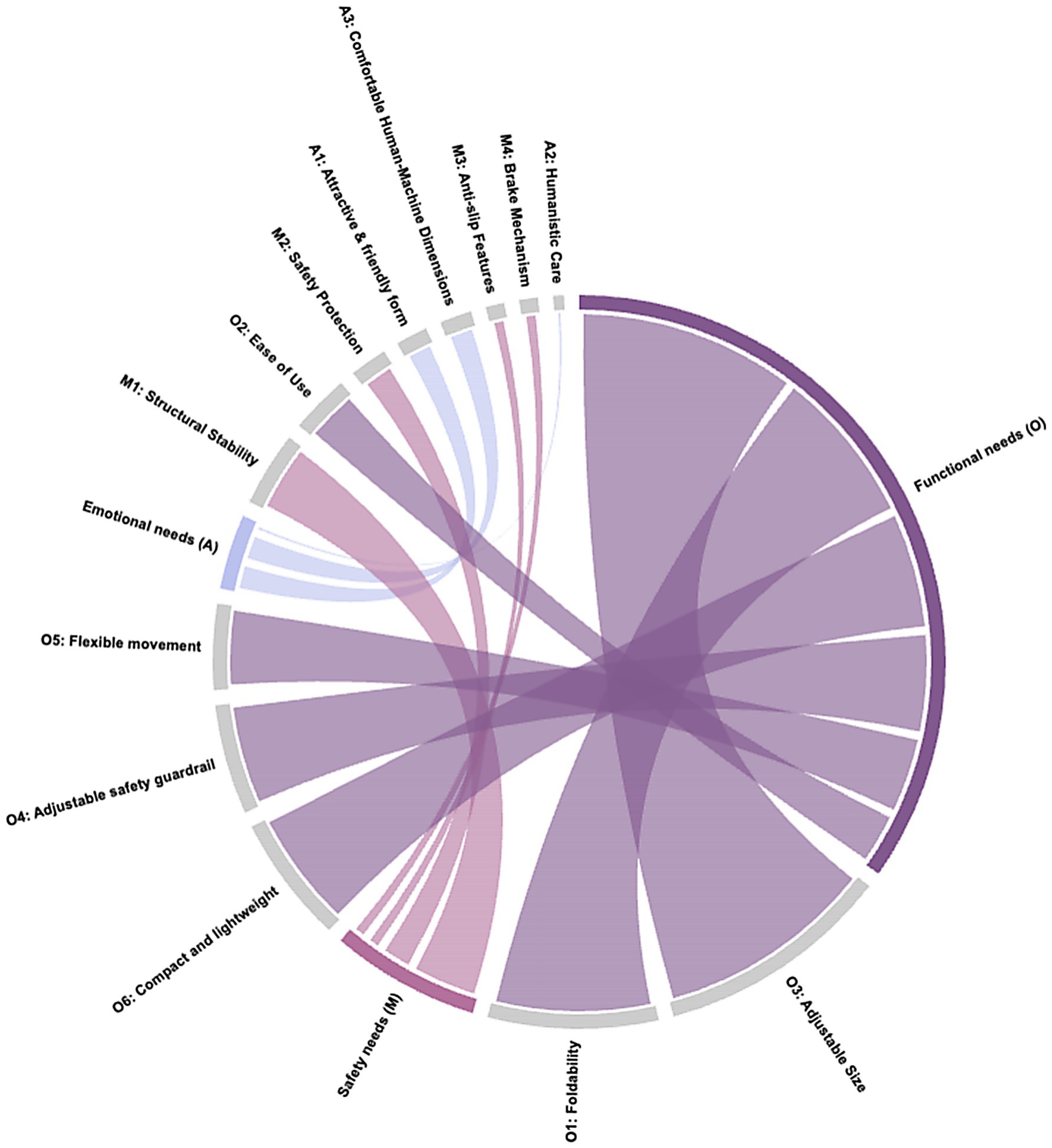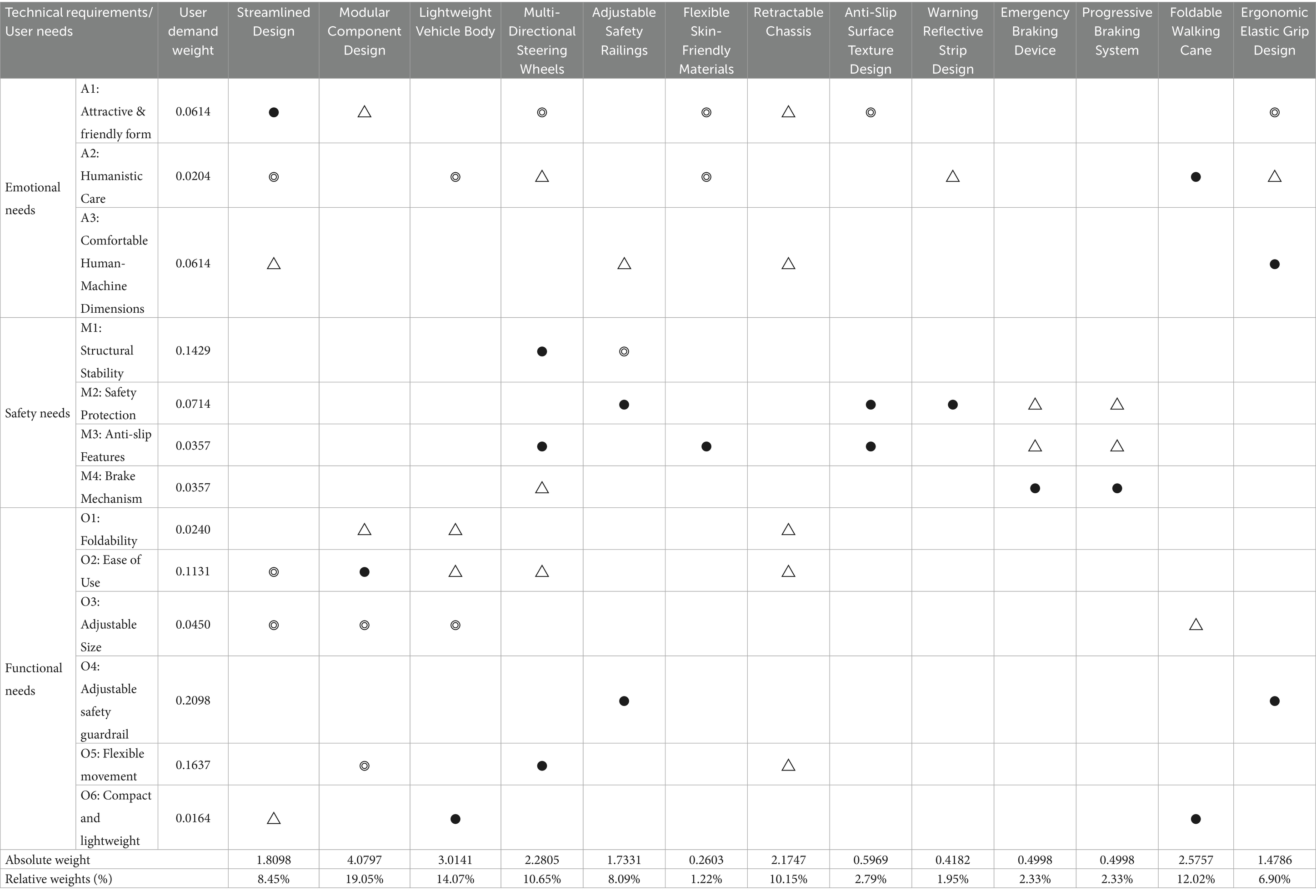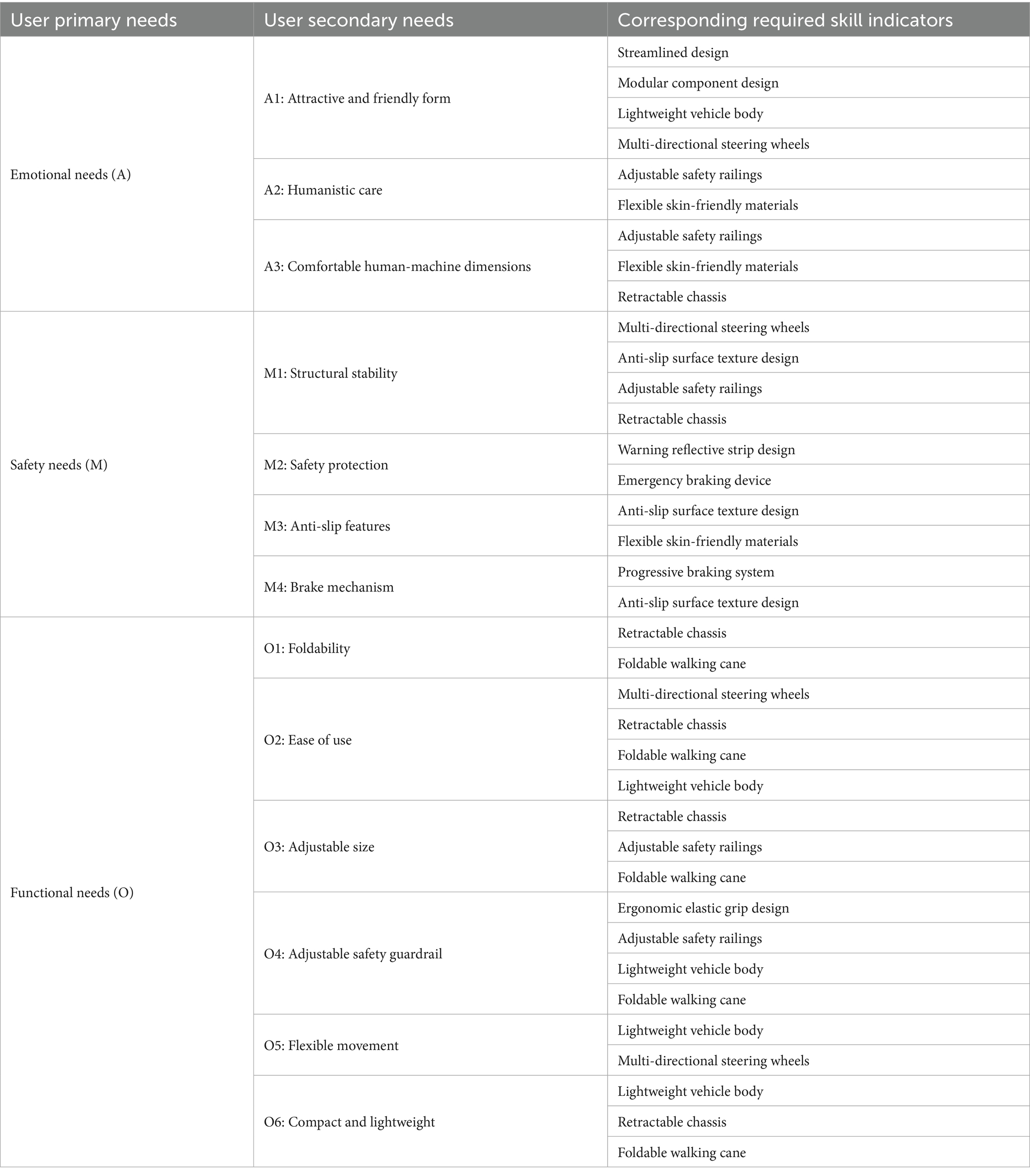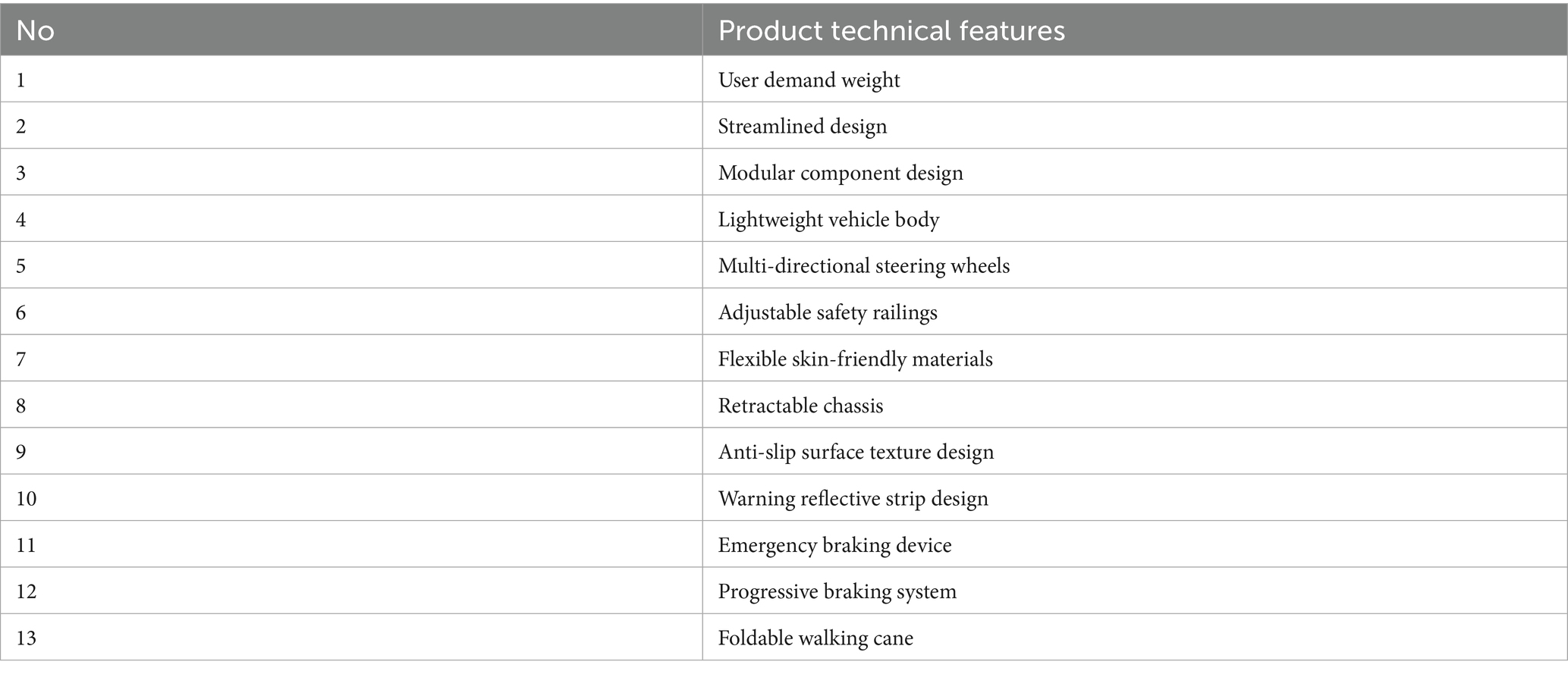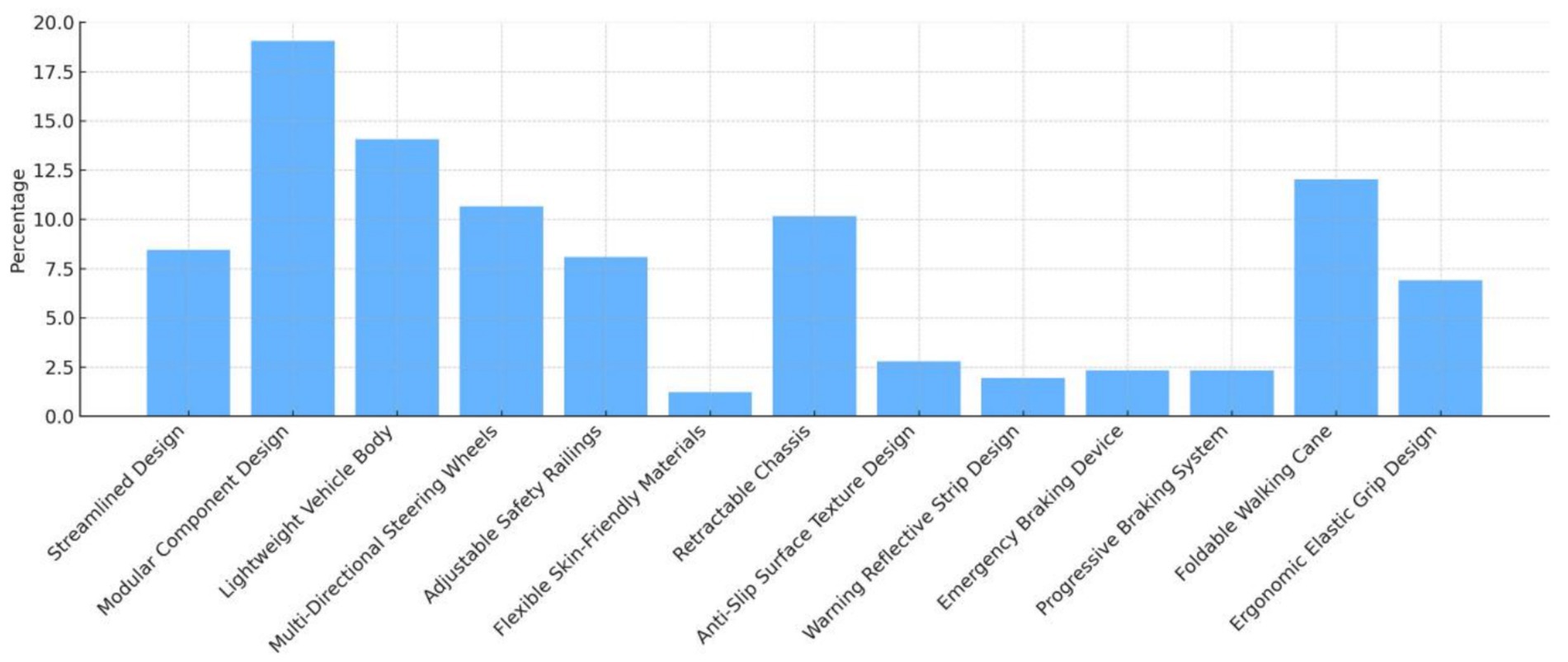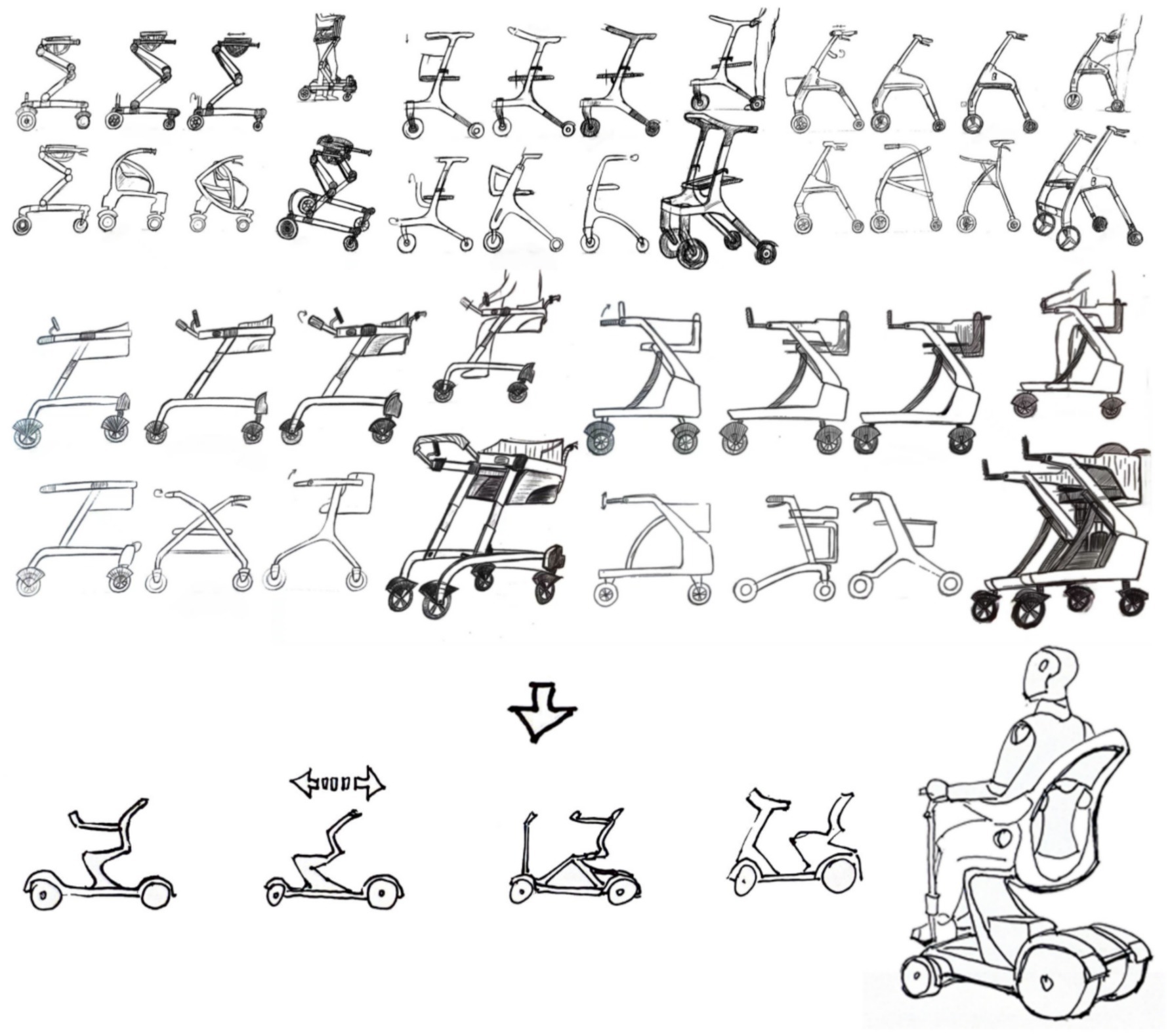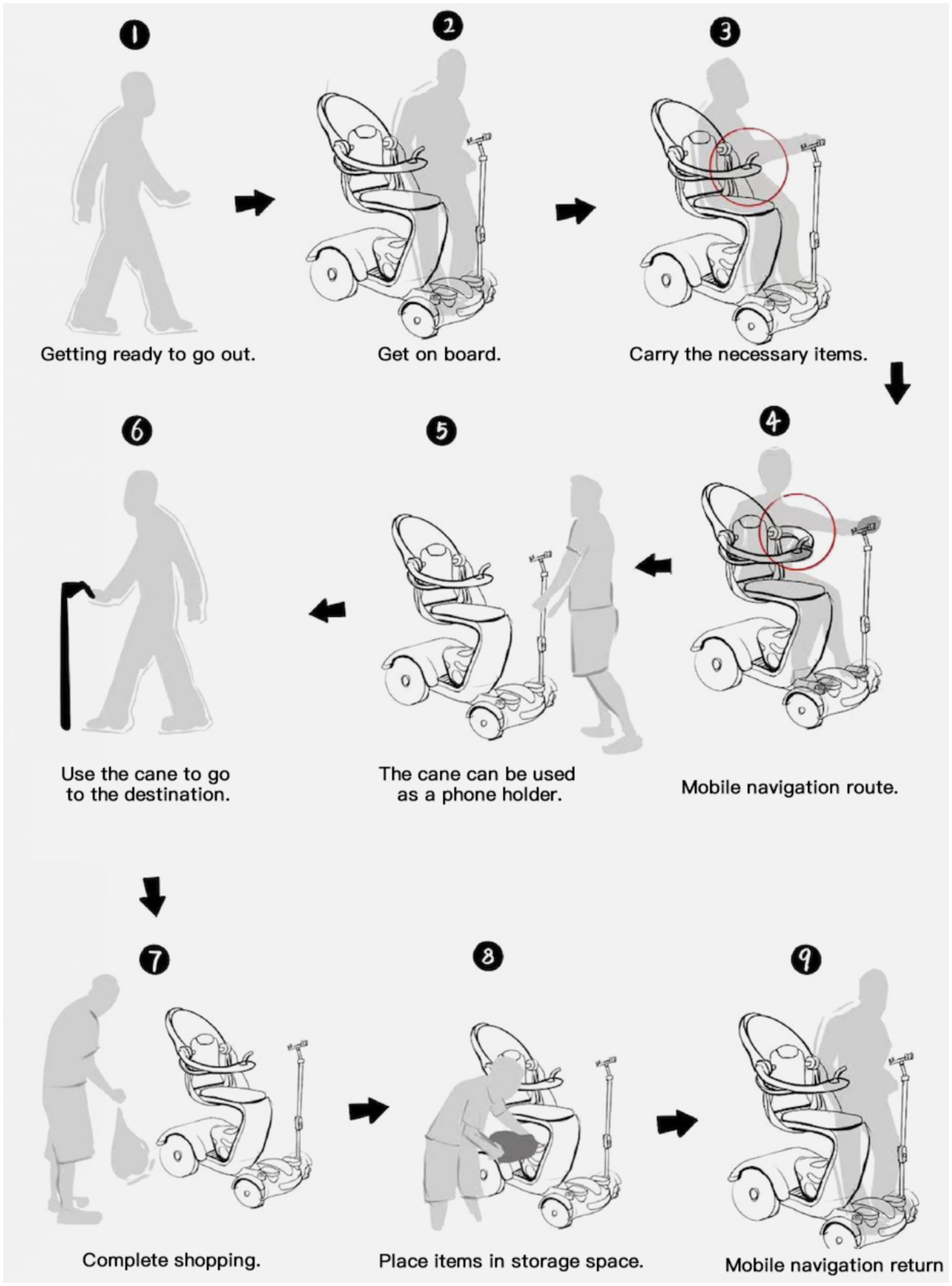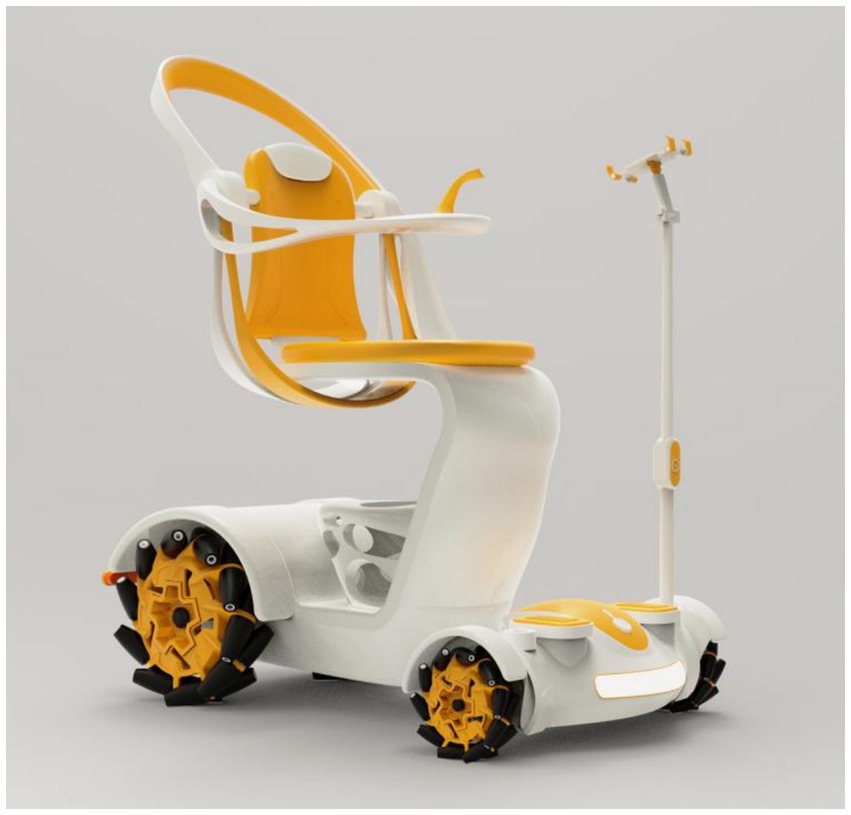- 1Hubei Business College, School of Art and Communication, Wuhan, China
- 2Faculty of Fine and Applied Arts, Burapha University, Mueang Chonburi, Thailand
Introduction: The global trend of population aging is irreversible, and the safety of older adults mobility has become an increasing concern. In response to the gap between rapidly growing market demand and limited academic research, this study proposes a design methodology for older adults mobility scooters guided by the four stages of the Double Diamond model.
Methods: In the Discover stage, core user requirements were identified through user behavior observation and the Kano model. In the Define stage, multi-criteria decision-making (MCDM) was used to calculate the weight of each requirement. In the Develop stage, Quality Function Deployment (QFD) translated high-priority user needs into technical features and calculated their hierarchical weights. In the Deliver stage, these technical features were further translated into concrete design solutions.
Results: This study provides a comprehensive and systematic framework for the innovative design of older adults mobility scooters. It aims to enhance the feasibility and design efficiency of older adults mobility products and contribute to addressing the challenges of population aging.
1 Introduction
The global aging population has become a critical and pressing issue, with far-reaching implications for healthcare systems, social structures, and economies (1). Studies show that the proportion of older adults individuals is steadily increasing worldwide, driven by declining birth rates and extended life expectancy (2). This demographic shift presents profound challenges, including a surge in age-related health conditions, such as musculoskeletal disorders, cardiovascular diseases, and cognitive decline (3). These issues not only reduce the mobility and independence of older adults individuals but also increase their risk of developing depression (4, 5).
The World Health Organization highlights that as individuals age, the decline in physical function becomes a major factor leading to the loss of independence and reduced quality of life among older adults (6). Addressing these challenges requires prioritizing the improvement of mobility in older adults populations. Mobility aids for older adults, such as mobility scooters, are essential in addressing this need.
However, due to the rapid growth of the market, mobility scooter manufacturers and designers often fail to meet the increasingly complex and evolving needs of older users (7). This has led to several critical issues that remain unresolved. First, complicated user interfaces and unfriendly controls severely limit the ability of older adults individuals to use these devices independently (8), thereby compromising their autonomy in daily life. Second, most current products lack adequate consideration of ergonomics, comfort, and safety (7), resulting in poor user experience during long-term use. More importantly, emotional care and social identity have long been overlooked in the design of these products (9). The appearance, materials, and functional configuration of many mobility scooters still exhibit a strong “medical device” esthetic (10), which fails to foster a sense of dignity or belonging for users (11). When used in public settings, these devices often lead to feelings of being stared at or stigmatized, further reinforcing the marginalization of older adults (12).
Therefore, mobility scooters should not only address physical needs but also convey care, respect, and esthetic value through design. A thoughtful design approach can help eliminate the psychological burden of social stigma among older users and promote their active participation and confident expression in society. This study aims to explore a new intelligent mobility scooter that integrates both human-centered care and technological rationality. Through innovative design language and multidimensional functional integration, we seek to provide the aging population with a dignified and emotionally supportive mobility solution.
To meet the growing demand for high-quality mobility scooters among older adults, it is crucial to adopt scientifically grounded design methods that enhance user satisfaction. Achieving user satisfaction among older adults populations involves multiple interrelated factors, making it a typical multi-criteria decision-making (MCDM) problem. MCDM methods have been widely validated as effective tools in diverse design applications (13–16). Among these, the Analytic Hierarchy Process (AHP) is one of the most established and widely applied approaches in MCDM. For example, Liu et al. used the AHP method to optimize the function and user experience of public electric vehicle charging stations (17). Similarly, Xie et al. applied AHP to guide the esthetic design of public facilities at Xiong’an Railway Station (18). Although AHP has been criticized for its subjectivity (19), several complementary techniques—particularly the Kano model (20) and Quality Function Deployment (QFD) (21)—have proven effective in mitigating these limitations. When initial product requirements are unclear, user journey mapping can help identify key pain points in current older adults mobility scooter use and extract core design elements (22). In the needs analysis stage, the Kano model assists designers in understanding how users evaluate product features and in prioritizing needs that most strongly impact satisfaction (23). In terms of evaluating design elements, AHP allows a structured analysis of the relative importance of each user requirement, offering clearer guidance to designers (24). Finally, in the product development stage, QFD can translate abstract requirements into actionable design parameters, ensuring the alignment of product features with user expectations (25).
The Double Diamond model, developed by the UK Design Council in 2004 (26), is a widely recognized framework for design thinking. Its core value lies in accurately identifying the right problem and delivering appropriate solutions. As a standardized methodology, it has been proven effective across a wide range of design projects (27). In this study, the application of the Double Diamond model provides a clear and structured approach to user-centered product development. Its use not only enhances methodological rigor but also strengthens the alignment between user insights and the final design outcomes.
Building upon these strengths, this study integrates the Double Diamond design model with a Multi-Criteria Decision-Making (MCDM) approach to establish a comprehensive design framework for older adults-oriented mobility scooters. This integrated framework not only accommodates the multifaceted and evolving needs of senior users but also provides actionable insights for designers aiming to develop functionally effective and user-centered assistive mobility solutions.
2 Materials and methods
This study primarily focuses on methodological research and does not involve human organs, animal tissues, or other living organisms. Human participation in this study is limited to behavioral observation and interview surveys focusing on older adults individuals in outdoor environments. Before the study commenced, the researchers informed all participants about the purpose of the research, the survey process, the use of the collected data, and the participants’ rights, obtaining their consent. All participants signed the informed consent form. Behavioral observations and interviews were conducted from May 10 to July 10, 2024. To ensure participants’ privacy, all data were anonymized so that no personal information could be identified. The research methods and procedures comply with ethical standards and regulations. This study was approved by the Ethics Review Committee of Hubei Business College. Ethics Approval Number: 202405043.
This study adopted the Double Diamond design model in combination with the user journey map to guide the innovative design of a mobility scooter for older adults users. The design process was divided into four key stages:
1. Problem Identifilcation: User behavior was observed to identify pain points in the daily use of mobility scooters by older adults. These insights were visualized to determine relevant design entry points.
2. Problem Definition: The Kano model was applied to categorize user needs into basic, performance, and attractive attributes. These needs were further prioritized using the Analytic Hierarchy Process (AHP) to identify those with the highest weights.
3. Design Development: The Quality Function Deployment (QFD) method was used to construct the House of Quality. This step translated prioritized user needs into specific technical features for product development.
4. Design Implementation: The final design phase focused on targeted product development guided by the technical indicators identified through QFD. The flowchart is shown in Figure 1.
3 Analysis and results
3.1 Older adults mobility scooter user needs
In this study, the Kano model is used to identify key user needs in the design of Older adults Mobility Scooters. The Kano model, developed by Japanese scholar Noriaki Kano, provides a comprehensive framework for understanding customer satisfaction through different categories of product features (28). It was further explored by Berger and colleagues, who highlighted its significance in quality management and customer satisfaction (29). This model has found wide applications across various industries, from airline services to leadership theory and even in areas such as radical innovation and political elections (30, 31). It has become a valuable tool in contemporary research, especially in product design and service optimization to enhance user satisfaction (32–34). To better understand the latent needs of older adults users, this study observed the complete shopping process of five individuals aged 65 and older who used mobility scooters to visit a supermarket. The focus was on identifying the challenges they encountered and their potential needs during the outing, as illustrated in Figure 2.
By analyzing the behavioral journey map of older adults users, we can identify opportunity points in the design of mobility scooters for seniors and categorize them into functional needs (O), safety needs (M), and emotional needs (A), as shown in Table 1.
3.2 KANO questionnaire design and analysis
This study uses the KANO model to classify user needs into five categories: Must-be Requirements (M), One-dimensional Requirements (O), Attractive Requirements (A), Indifferent Requirements (I), and Reverse Requirements (R) (35). The specific user needs for Older adults Mobility Scooter design are detailed in Table 2.
The Kano questionnaire captures responses from both positive and negative perspectives. Positive questions represent satisfied needs, while negative questions address unmet ones. Each question offers five response options: Like (5), Must-be (4), Neutral (3), Live with (2), and Dislike (1). The demand attributes for each element are determined based on the evaluation criteria in Table 3.
The sample was drawn from a provincial capital in central China, where the distinct seasonal climate allows for better observation of older adults living habits from a climatic perspective. To identify key design elements for walking aids, questionnaires were distributed in three nursing homes, each housing over 50 residents. A preliminary questionnaire design is shown in Table 4, with the full version in Appendix S1. A total of 130 questionnaires were distributed, yielding 91 valid responses. Among the respondents, 72.5% were male, 27.5% were female, and ages ranged from 60 to 85 years.
To ensure the dependability of the questionnaire data for further analysis, a reliability assessment was conducted. Table 5 shows that the Cronbach’s α values for both positive and negative items exceed 0.8, indicating high reliability and suitability for subsequent calculations.
To assess the reasonableness of the questionnaire design and collected data, SPSS software was used for analysis. The KMO value was 0.776, and Bartlett’s test of sphericity produced an approximate chi-square value of 576.25, as shown in Table 6. These findings confirm the questionnaire’s high validity.
The Satisfaction Index (SI) and Dissatisfaction Index (DSI) are key metrics, where SI is typically positive and DSI is usually negative. Refer to Formulas 1, 2 for details.
The Better-Worse coefficient reflects the selection ratio of each demand. A SI close to 1 indicates that fulfilling the demand increases user satisfaction, while a DSI near −1 suggests that not fulfilling the demand may enhance satisfaction. The analysis results of the Kano questionnaire user needs are shown in Table 7.
The KANO model analysis highlights significant differences in how various needs affect user satisfaction. As shown Figure 3. Excitement Needs (e.g., easy operation, reducing upper limb strain, ergonomic dimensions) are critical for enhancing satisfaction and warrant focused innovation. Performance Needs (e.g., adjustable size, foldable design, compact structure, appealing esthetics) align closely with user expectations and require optimization. Basic Needs (e.g., structural stability, safety protection, anti-slip mechanisms) are essential and must be fully met, while Indifferent Needs (e.g., reflective strips, decorative accessories) have minimal impact and can be excluded.
3.3 User requirement analysis using the analytic hierarchy process (AHP)
In this study, Analytic Hierarchy Process (AHP) is used to establish and rank user requirement indicators, reducing design biases that may stem from subjective designer intentions. The Analytic Hierarchy Process (AHP) is a multi-criteria decision-making method introduced by Thomas L. Saaty in the 1970s (36). This method systematically integrates qualitative and quantitative analysis (37). AHP is especially effective for complex decision-making, helping decision-makers make well-informed choices based on multiple criteria (38, 39). Research has shown that AHP plays a crucial role in policymaking, project evaluation, business management, and strategic planning (39–41).
Based on the analysis of the Kano questionnaire, user satisfaction is primarily influenced by Basic Needs (M), Performance Needs (O), and Excitement Needs (A), whereas Indifferent Needs (I) have little impact. As a result, 13 out of 16 design elements were selected as key evaluation criteria. Subsequently, the Analytic Hierarchy Process (AHP) was employed to establish a hierarchical model with three levels: the Goal Layer, the Criteria Layer, and the Indicator Layer. Detailed information is presented in Table 8.
To enhance the rigor of the study, we assembled a review panel consisting of 10 experts and users. The panel includes: 2 full-time older adults care workers with 10 years of professional experience; 3 senior physical therapists; 2 designers specializing in medical assistive devices; 2 rehabilitation therapists with over 5 years of clinical experience; and 1 rehabilitation psychotherapy expert with more than 10 years of experience in older adults psychological and emotional therapy. The scoring criteria are detailed in Table 9, the weights of the criterion-level attributes are presented in Table 10, and the weights for secondary needs are shown in Tables 11–13.
To ensure the reliability of the weights at the criterion and sub-criterion levels, consistency checks were performed using Formula 3. As shown in Table 14, all consistency ratios (CR) are below 0.1, confirming that the consistency requirements are satisfied.
The resulting calculations are detailed in Table 15, and a chord diagram for the weight values is shown in Figure 4.
By referencing the importance rankings in Table 15, designers can systematically prioritize key factors in the development of walking aids for the older adults, ensuring a more effective and user-centered design approach.
3.4 QFD indicator conversion
After calculating the user requirement weights for older adults mobility scooters using the Analytic Hierarchy Process (AHP), we applied Quality Function Deployment (QFD) to translate these requirements into technical specifications. The core of this process is the House of Quality (HOQ), which acts as a bridge between the “Voice of the Customer” and the “Voice of the Engineer” (42). The HOQ visually maps the relationship between user needs and product technical features. It also helps calculate the absolute and relative weights of these features, enabling the identification of potential issues in the design process. The HOQ construction involves the following steps:
Step 1: Construct the left wall of the HOQ.
Import the user requirements and their overall weights from Table 15 into the left wall of the House of Quality (HOQ), as shown in Table 16.
Step 2: Construct the roof of the HOQ.
Based on the technical indicators required to meet user needs, analyze and expand the technical specifications of the older adults mobility scooter (see Table 17).
Step 3: Summarize technical characteristics.
Refine and consolidate the results from Table 17 to generate a summary of the technical features of the older adults mobility scooter, as shown in Table 18.
Step 4: Import technical features into the HOQ.
Transfer the summarized technical features into the roof of the HOQ to establish the technical requirements.
Step 5: Construct the body of the HOQ.
Analyze the correlation between user needs and product technical features. Use ● (strong correlation), ◎ (moderate correlation), and △ (weak correlation) to indicate the strength of each relationship: ● = 5, ◎ = 3, △ = 1, and blank = 0. The correlation matrix is shown in Table 16.
Step 6: Construct the base of the HOQ.
Calculate the absolute and relative weights of each technical feature using Equations 4, 5. Import the results into the base of the HOQ, as presented in Table 16. The specific calculation formulas are as follows:
In the formula:
——Absolute weight of the quality characteristics of the older adults mobility scooter;
——Comprehensive weight of user requirements;
——Correlation coefficient between user requirements and quality characteristics;
——Relative weight of the quality characteristics of the older adults mobility scooter.
Based on the above steps, the final House of Quality (HOQ) model for the product is obtained, as shown in Table 16.
Table 16 highlights that among all technical requirements, Modular Component Design, Lightweight Vehicle Body, and Adjustable Safety Railings obtained the highest relative weights, indicating their central roles in meeting older adults users’ needs for safety, comfort, and portability. In contrast, Flexible Skin-Friendly Materials, Warning Reflective Strip Design, and Anti-Slip Surface Texture Design exhibited comparatively lower weights, suggesting they serve as supplementary features to enhance user experience rather than core performance factors. Overall, the HOQ analysis quantitatively clarifies the hierarchy of design priorities and provides a data-driven foundation for the subsequent prototype development.
Based on the QFD (Quality Function Deployment) approach, a House of Quality model was developed to determine the relative importance of various design features, as shown in Figure 5. The analysis reveals that in the design of mobility scooters for older adults users, Modular Component Design (19.05), Lightweight Vehicle Body (14.07), Foldable Walking Cane (12.02), Multi-Directional Steering Wheels (10.65), and Retractable Chassis (10.15) received the highest importance weights. These features represent the most critical design priorities and should be given top consideration in subsequent product development. Following these, Streamlined Design (8.45), Adjustable Safety Railings (8.09), and Ergonomic Elastic Grip Design (6.90) also hold significant importance and should be optimized during the design process. In contrast, Flexible Skin-Friendly Materials (1.22), Warning Reflective Strip Design (1.95), Anti-Slip Surface Texture Design (2.79), Emergency Braking Device (2.33), and Progressive Braking System (2.33) are relatively less critical. While these features should not be ignored, they may receive comparatively lower priority when design resources are limited.
3.5 Discussion and result
Based on the analyzed design elements of the older adults mobility scooter, an initial prototype design was developed, as shown in Figure 6.
Based on the problems identified through early-stage user behavior analysis, the designer proposed solutions through conceptual sketches and developed an experimental prototype accordingly. This process involved an immersive analysis of product usage scenarios to address real user pain points. The prototype is shown in Figure 7.
This electric mobility scooter emphasizes Modular Component Design, enhancing the product’s ease of use. The Lightweight Vehicle Body improves portability and ease of operation, making it especially suitable for older adults users with limited physical strength. The integration of a Foldable Walking Cane ensures continued mobility support even after dismounting, reflecting thoughtful consideration of real-life usage scenarios. In addition, Multi-Directional Steering Wheels significantly improve maneuverability in confined spaces, while the Retractable Chassis allows the scooter to adapt to various environments such as narrow corridors or storage areas. Other enhancements—including Streamlined Design, Adjustable Safety Railings, and Ergonomic Elastic Grip Design—further elevate overall safety, comfort, and user experience. As shown in Figure 8.
4 Conclusion
Due to the aging population, the demand for assistive products for the older adults is steadily increasing. However, traditional product designs often focus solely on basic functional requirements, while overlooking the emotional needs of older adults users and the complexity of their mobility-related demands. To address this gap, this study proposes an innovative mobility scooter design that prioritizes Modular Component Design, a Lightweight Vehicle Body, and an integrated Foldable Walking Cane to enhance the mobility experience of older adults. These user-centered design features collectively improve the overall quality of the mobility scooter and provide designers with targeted and practical design guidance.
Previous studies have shown that applying user-centered, multidimensional design decision-making methods in the design field can significantly enhance the feasibility of proposed solutions. For instance, Wu et al. utilized the Kano-AHP method to develop a quantifiable design approach for future smart jewelry (43). Cai et al. employed the KANO-AHP-FCE model to create culturally inspired products with an emphasis on emotional connections (44). However, these studies primarily focused on the weighting and evaluation stages, lacking an integrated framework that systematically guides the early discovery, definition, and iterative development of user needs.
Compared with previous studies, this research makes methodological improvements by embedding the Kano–AHP–QFD decision-making sequence within the Double Diamond design model. This integrated approach unifies user research, requirement prioritization, and design implementation into a coherent process, thereby enhancing methodological consistency and user-centered responsiveness. By combining exploratory qualitative analysis with quantitative evaluation, the study strengthens the scientific rigor of design decision-making and validates the effectiveness of the proposed framework through the development of an innovative product prototype.
Although this study has made some progress in uncovering latent user needs and improving the feasibility of decision-making, there are still certain limitations. For instance, during the user needs acquisition phase, the participants were older adults individuals from northern China. This sampling approach may lead to potential selection bias, as regional differences in living environments could result in variations in mobility habits, cultural preferences, and product use patterns among older adults. Additionally, most participants were recruited from nursing institutions rather than community settings, which may limit the generalizability of the findings to the broader older adults population. Furthermore, the sample size of observed participants was relatively small, and differences across age groups and body types could also influence users’ requirements for mobility scooters. Future research should expand the scope of the study to include older adults populations from diverse regions and living environments, allowing for a more comprehensive understanding of user diversity.
Moreover, the limited number of experts involved in the needs assessment may have influenced the precision of the results. Expanding the expert sample in future studies could ensure more balanced and reliable evaluations. In addition, this study did not include a large-scale sensitivity analysis of AHP weight variations due to resource constraints. Subsequent work will perform a detailed sensitivity analysis with a larger and more diverse sample to further verify the robustness and stability of the weighting results and strengthen the methodological reliability of the proposed framework.
Data availability statement
The original contributions presented in the study are included in the article/Supplementary material, further inquiries can be directed to the corresponding author/s.
Ethics statement
The studies involving humans were approved by the Ethics Review Committee of Hubei Business College. Ethics Approval Number: 202405043. Human participation in this study is limited to behavioral observation and interview surveys focusing on older adults individuals in outdoor environments. Before the study commenced, the researchers informed all participants about the purpose of the research, the survey process, the use of the collected data, and the participants’ rights, obtaining their consent. All participants signed the informed consent form.
Author contributions
XW: Conceptualization, Data curation, Formal analysis, Funding acquisition, Investigation, Methodology, Project administration, Resources, Software, Supervision, Validation, Visualization, Writing – original draft, Writing – review & editing. ZZ: Data curation, Formal analysis, Validation, Writing – review & editing. HY: Investigation, Project administration, Writing – review & editing. HA: Resources, Writing – review & editing.
Funding
The author(s) declare that no financial support was received for the research and/or publication of this article.
Acknowledgments
The authors would like to express their sincere gratitude to their supervisors and colleagues for their valuable guidance, constructive feedback, and continuous encouragement throughout the research process. Special thanks are also extended to all team members who contributed to data collection, prototype development, and manuscript preparation. Their dedication and collaboration made this work possible.
Conflict of interest
The authors declare that the research was conducted in the absence of any commercial or financial relationships that could be construed as a potential conflict of interest.
Generative AI statement
The authors declare that no Gen AI was used in the creation of this manuscript.
Any alternative text (alt text) provided alongside figures in this article has been generated by Frontiers with the support of artificial intelligence and reasonable efforts have been made to ensure accuracy, including review by the authors wherever possible. If you identify any issues, please contact us.
Publisher’s note
All claims expressed in this article are solely those of the authors and do not necessarily represent those of their affiliated organizations, or those of the publisher, the editors and the reviewers. Any product that may be evaluated in this article, or claim that may be made by its manufacturer, is not guaranteed or endorsed by the publisher.
Supplementary material
The Supplementary material for this article can be found online at: https://www.frontiersin.org/articles/10.3389/fpubh.2025.1672580/full#supplementary-material
References
1. Wister, AV, and Speechley, M. Inherent tensions between population aging and health care systems: what might the Canadian health care system look like in twenty years? J Popul Ageing. (2015) 8:227–43. doi: 10.1007/s12062-015-9123-1
2. O’Caoimh, R, Sezgin, D, O’Donovan, MR, Molloy, DW, Clegg, A, Rockwood, K, et al. Prevalence of frailty in 62 countries across the world: a systematic review and meta-analysis of population-level studies. Age Ageing. (2021) 50:96–104. doi: 10.1093/ageing/afaa219
3. Li, Z, Zhang, Z, Ren, Y, Wang, Y, Fang, J, Yue, H, et al. Aging and age-related diseases: from mechanisms to therapeutic strategies. Biogerontology. (2021) 22:165–87. doi: 10.1007/s10522-021-09910-5
4. Pantelaki, E, Maggi, E, and Crotti, D. Mobility impact and well-being in later life: a multidisciplinary systematic review. Res Transp Econ. (2021) 86:100975. doi: 10.1016/j.retrec.2020.100975
5. Strawbridge, WJ, Deleger, S, Roberts, RE, and Kaplan, GA. Physical activity reduces the risk of subsequent depression for older adults. Am J Epidemiol. (2002) 156:328–34. doi: 10.1093/aje/kwf047
6. Beard, JR, Officer, A, De Carvalho, IA, Sadana, R, Pot, AM, Michel, JP, et al. The world report on ageing and health: a policy framework for healthy ageing. Lancet. (2016) 387:2145–54. doi: 10.1016/S0140-6736(15)00516-4
7. Wang, T, Zhao, Y, Zhang, X, Xie, Y, and Pang, LLL. Design of walking aids for the older adults based on the Kano-AHP-FEC method. Sci Rep. (2025) 15:2663. doi: 10.1038/s41598-025-85540-y
8. Lim, PY, Hui Chia, CW, Ong, SL, Lim, ML, and Xu, T. The impact of mobility scooter on occupational participation among older adults in Singapore: an exploratory study. Disabil Rehabil Assist Technol. (2024) 19:745–53. doi: 10.1080/17483107.2022.2121008
9. Chen, K. Why do older people love and hate assistive technology?–an emotional experience perspective. Ergonomics. (2020) 63:1463–74. doi: 10.1080/00140139.2020.1808714
10. Zhang, B, Ma, M, and Wang, Z. Promoting active aging through assistive product design innovation: a preference-based integrated design framework. Front Public Health. (2023) 11:1203830. doi: 10.3389/fpubh.2023.1203830
11. Felber, NA, Pageau, F, McLean, A, and Wangmo, T. The concept of social dignity as a yardstick to delimit ethical use of robotic assistance in the care of older persons. Med Health Care Philos. (2022) 25:99–110. doi: 10.1007/s11019-021-10054-z
12. Hansen, AM. Dignity equals distance? Pursuing dignity in care for older adults. Ageing Soc. (2023) 43:1003–21. doi: 10.1017/S0144686X21000891
13. Janeš, A, Kadoić, N, and Begičević Ređep, N. Differences in prioritization of the BSC’S strategic goals using AHP and ANP methods. J Inf Organ Sci. (2018) 42:193–217. doi: 10.31341/jios.42.2.3
14. Fountzoula, C, and Aravossis, K. Decision-making methods in the public sector during 2010–2020: a systematic review. Adv Oper Res. (2022) 2022:1–13. doi: 10.1155/2022/1750672
15. Jorge-García, D, Estruch-Guitart, V, and Aragonés-Beltrán, P. How does the type of MCDM method affect the results of the prioritization and assessment of ecosystem services? A case study in the Ebro River Delta (Spain). J Clean Prod. (2023) 429:139637. doi: 10.1016/j.jclepro.2023.139637
16. Zhao, X, and Binti Che Amat, R. Application and evaluation of traditional garden culture in modern urban landscape design under the context of cultural sustainability. PLoS One. (2025) 20:e0324613. doi: 10.1371/journal.pone.0324613
17. Liu, X. Research on function optimization of electric vehicle charging stations based on user demand analysis: an empirical study using the Kano model and AHP method. Sustainability. (2024) 16:10783. doi: 10.3390/su162310783
18. Xie, XH, Zhu, H, Xu, Y, Yan, H, Guo, S, and Liu, Q. Aesthetic design and evaluation of public facilities in railway stations under the background of sustainable development: a case of an information counter at xiong’an Railway Station. Sustainability. (2024) 16:5021. doi: 10.3390/su16125021
19. Mikaeil, R, Ataei, M, and Yousefi, R. Evaluating the power consumption in carbonate rock sawing porocess by using FDAHP and TOPSIS techniques In: R Mikaeil, editor. Efficient decision support systems—Practice and challenges in multidisciplinary domains. London: IntechOpen (2011). 413–36.
20. Xi, L, Zhang, H, Li, S, and Cheng, J. Integrating fuzzy Kano model and fuzzy importance–performance analysis to analyse the attractive factors of new products. Int J Distrib Sensor Netw. (2020) 16:2022. doi: 10.1177/1550147720920222
21. Kürüm Varolgüneş, F, Canan, F, del Río-Rama, MDLC, and Oliveira, C. Design of a thermal hotel based on AHP-QFD methodology. Water. (2021) 13:2109. doi: 10.3390/w13152109
22. Vasilieva, E. Design thinking in the development of project management approaches and modeling of business processes of the organization In: E Vasilieva, editor. Digital transformation and new challenges. Cham: Springer (2021). 3–16.
23. Shahin, A, and Nekuie, N. Development of the Kano model: a novel approach based on linear logarithmic transformation with a case study in an air travel agency. Asian J Qual. (2011) 12:176–88. doi: 10.1108/15982681111158733
24. Saaty, TL. Decision making with the analytic hierarchy process. Int J Serv Sci. (2008) 1:83–98. doi: 10.1504/IJSSCI.2008.017590
25. Apichonbancha, P, Lin, RH, and Chuang, CL. Integration of principal component analysis with AHP-QFD for improved product design decision-making. Appl Sci. (2024) 14:5976. doi: 10.3390/app14145976
26. Wang, X, Huang, Z, Xu, T, Li, Y, and Qin, X. Exploring the future design approach to ageing based on the double diamond model. Systems. (2023) 11:404. doi: 10.3390/systems11080404
27. Saad, E, Elekyaby, MS, Ali, EO, and Hassan, SFAE. Double diamond strategy saves time of the design process. Int Des J. (2020) 10:211–22. doi: 10.21608/idj.2020.96345
28. Seraku, N, Takahashi, F, and Tsuji, S. Attractive quality and must-be quality. Hinshitsu J Jpn Soc Qual Control. (1984) 1:39–48.
29. Berger, C, Blauth, R, Boger, D, Bolster, C, Burchill, G, DuMouchel, W, et al. Kano’s methods for understanding customer-defined quality. Center Qual Manag J. (1993) 4:3–36.
30. Salehzadeh, R, Shahin, A, Kazemi, A, and Shaemi Barzoki, A. Proposing a new approach for evaluating the situational leadership theory based on the Kano model. Int J Public Leadersh. (2015) 11:4–20. doi: 10.1108/ijpl-05-2014-0003
31. Shahin, A, Mohammadi, S, Harsij, H, and Rahbar Qazi, MR. Revising satisfaction and dissatisfaction indexes of the Kano model by reclassifying indifference requirements - a case study of the presidential elections. TQM J. (2017) 29:37–54. doi: 10.1108/TQM-05-2015-0059
32. Xu, Q, Jiao, RJ, Yang, X, Helander, M, Khalid, HM, and Opperud, A. An analytical Kano model for customer need analysis. Des Stud. (2009) 30:87–110. doi: 10.1016/j.destud.2008.07.001
33. Kohli, A, and Singh, R. An assessment of customers’ satisfaction for emerging technologies in passenger cars using Kano model. Vilakshan. (2021) 18:76–88. doi: 10.1108/XJM-08-2020-0103
34. Deng, X, Liu, L, and Zhang, R. Optimization design of fitness game system based on Kano-QFD. Packag Eng. (2021) 42:148–54. doi: 10.19554/j.cnki.1001-3563.2021.14.017
35. Han, D, and Husle, H. Study on charm properties of aging nightstand based on fuzzy Kano model. Forest Prod Industry. (2024) 1:1–10.
37. Liu, Y, Eckert, CM, and Earl, C. A review of fuzzy AHP methods for decision-making with subjective judgements. Expert Syst Appl. (2020) 161:113738. doi: 10.1016/j.eswa.2020.113738
38. Zandi, P, Rahmani, M, Khanian, M, and Mosavi, A. Agricultural risk management using fuzzy TOPSIS analytical hierarchy process (AHP) and failure mode and effects analysis (FMEA). Agriculture. (2020) 10:504. doi: 10.3390/agriculture10110504
39. Zhang, B, Xu, K, Khan, U, Li, X, Du, L, and Xu, Z. A lightweight convolutional neural network with end-to-end learning for three-dimensional mineral prospectivity modeling: a case study of the Sanhetun area, Heilongjiang Province, northeastern China. Ore Geol Rev. (2023) 163:105788. doi: 10.1016/j.oregeorev.2023.105788
40. Karasan, A, Ilbahar, E, Cebi, S, and Kahraman, C. Customer-oriented product design using an integrated neutrosophic AHP & DEMATEL & QFD methodology. Appl Soft Comput. (2022) 118:108445. doi: 10.1016/j.asoc.2022.108445
41. Neira-Rodado, D, Ortíz-Barrios, M, De la Hoz-Escorcia, S, Paggetti, C, Noffrini, L, and Fratea, N. Smart product design process through the implementation of a fuzzy Kano-AHP-DEMATEL-QFD approach. Appl Sci. (2020) 10:1792. doi: 10.3390/app10051792
42. Ginting, R, and Ishak, A. An integrated of AHP–QFD methodology for product design: a review. J Ilmiah Teknik Ind. (2020) 8:69–78.
43. Wu, Y, Yu, S, Zhang, M, and Hu, J. Research on smart wearable jewelry product design based on Kano-AHP. Packag Eng. (2024) 1:220–7. doi: 10.19554/j.cnki.1001-3563.2024.S1.029
Keywords: older adults mobility, product innovation design methodology, double diamond model, user requirements, population aging
Citation: Wang X, Zhao Z, Yuan H and Ai H (2025) A double diamond model-based approach to the innovative design of mobility scooters for the older adults. Front. Public Health. 13:1672580. doi: 10.3389/fpubh.2025.1672580
Edited by:
Hasheem Mannan, University College Dublin, IrelandReviewed by:
Ciro Gaona, Alzheimer's Foundation of Venezuela, VenezuelaLatha S., SRM Institute of Science and Technology, India
Copyright © 2025 Wang, Zhao, Yuan and Ai. This is an open-access article distributed under the terms of the Creative Commons Attribution License (CC BY). The use, distribution or reproduction in other forums is permitted, provided the original author(s) and the copyright owner(s) are credited and that the original publication in this journal is cited, in accordance with accepted academic practice. No use, distribution or reproduction is permitted which does not comply with these terms.
*Correspondence: Xianzhi Wang, MzA0MjEyNTY2NUBxcS5jb20=; Zefeng Zhao, Mzk4NjQ5MDg2NUBxcS5jb20=; Hang Yuan, aHVhbmcxMjM0QHFxLmNvbQ==
 Xianzhi Wang
Xianzhi Wang Zefeng Zhao2*
Zefeng Zhao2*